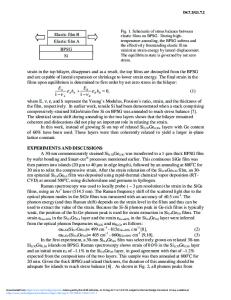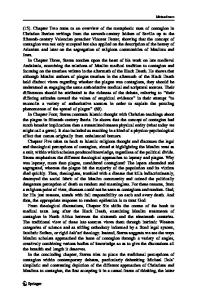Free Standing Silicon as a Compliant Substrate for SiGe
- PDF / 1,194,814 Bytes
- 6 Pages / 612 x 792 pts (letter) Page_size
- 46 Downloads / 314 Views
D4.6.1/G1.6.1
Free standing silicon as a compliant substrate for SiGe G. M. Cohen, P. M. Mooney and J.O. Chu IBM T. J. Watson Research Center, P.O. Box 218, Yorktown Heights, NY 10598, U.S.A Abstract: We show that SiGe grown on free-standing silicon is elastically relaxed. The free-standing Si structure consists of a ~30 nm-thick, 5 µm-square silicon slab supported by a SiO2 pedestal at a single contact point at the center of the square (the cross-section resembles a mushroom). A matrix of free-standing structures was made by patterning a bonded silicon-on-insulator (SOI) wafer and undercutting the SiO2 to form the pedestal. Un-patterned areas of the SOI wafer and the exposed bulk Si substrate were included as reference regions. A UHVCVD Si0.8Ge0.2 film, about 200 nm-thick, was grown epitaxially on both sides of the free-standing silicon and the surrounding exposed bulk Si. The SiGe was also grown on the un-patterned SOI and bulk substrate control areas. The SiGe film grown on both SOI and bulk silicon was found to be fully strained. In contrast, the SiGe layer grown on free-standing silicon is ~89% strain-relaxed, and the free-standing silicon film was measured to be under tensile strain. Since the same lattice mismatch was found between the SiGe layer and the Si on the free-standing silicon and on the SOI and bulk Si control regions, we conclude that the strain relaxation of the SiGe film on freestanding Si is elastic with the strain accommodated entirely by the free-standing silicon film under tensile strain. This was further confirmed by AFM measurements. The SiGe film on the control regions showed a very smooth SiGe surface with only a few surface steps originating from misfit dislocations at the SiGe/Si interface. No surface steps from misfit dislocations were observed on the surface of the SiGe film on free-standing Si. These results show that freestanding silicon serves as an ideal compliant substrate for SiGe. Introduction: The need to integrate semiconductors of different types is a challenge when their lattice constant is different and the epitaxial layer needs to be unstrained. Techniques such as growth of a thick strain-relaxed graded buffer layer [1], wafer bonding of two dissimilar materials [2], and the transfer of a semiconductor layer onto a compliant substrate, such as borophosphorosilicate glass that reflows at high temperature [3,4], have been proposed. A free-standing film is an ideal compliant substrate since it will elastically accommodate to the lattice mismatched film. The film has to be supported at a single point to avoid warping. Jones et al. have demonstrated that In0.15Ga0.85As cladding layers can be grown on a free-standing In0.05Ga0.95As disk [5]. Using photoluminescence and cathodoluminescence they observed light emission at 1.35 µm from a In0.4Ga0.6As quantum well sandwiched between the cladding layers. The long wavelength obtained from this layer structure indicates that cladding layers are not strained. In this work we investigated thin free-standing silicon films as a compliant
Data Loading...




